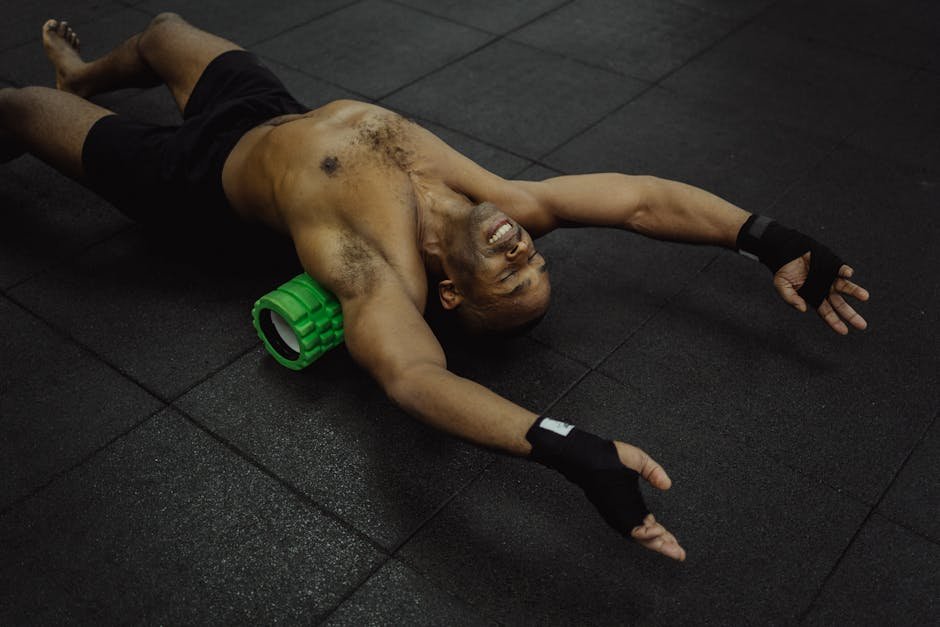The Art of Myofascial Release: Techniques for Pain Management
Myofascial release techniques are gaining attention for their potential to reduce pain and improve mobility through a holistic approach. Whether you're dealing with recurring knee pain or looking to regain strength, this hands-on therapy can be vital. Here's what you need to know:
Definition: A hands-on technique applying gentle pressure to myofascial tissues
Purpose: To alleviate pain, restore motion, and improve flexibility
Approach: Focuses on myofascial tissues affecting muscles, bones, and organs
Benefits: May include reduced pain, improved joint function, and stress relief
Myofascial release is part of a holistic, patient-centric approach, emphasizing customized treatment and functional movement.
As a dedicated expert in this field, I’m Lou Ezrick, the founder of Evolve Physical Therapy in Brooklyn. With nearly two decades of experience in chronic pain management and movement optimization, I've seen how myofascial release techniques can transform lives by addressing pain at the root level.
Understanding Myofascial Release
Myofascial release is a manual therapy technique that targets the fascia, a connective tissue wrapping around your muscles, nerves, and organs. Think of fascia like a web that holds your body together. When it's tight or restricted, it can cause pain and limit movement.
Fascia Manipulation: This involves using hands-on techniques to gently manipulate the fascia. By doing so, therapists aim to release tension and improve the flow of movement in your body. It’s like untangling a knot in a shoelace, allowing for smoother movement.
Gentle Sustained Pressure: The key to effective myofascial release is applying a low, constant pressure over a period of time. Imagine pressing on a piece of taffy until it softens and stretches out. This allows the fascia to elongate and return to its natural state, reducing pain and restoring mobility.
Myofascial Release Techniques
When it comes to myofascial release techniques, there are several methods to help alleviate pain and improve mobility. Let’s explore some of the most effective options, including self-myofascial release, using a foam roller, and targeting trigger points.
Self-Myofascial Release
Self-myofascial release is a way for individuals to manage their pain and tension at home. It involves using tools like foam rollers or massage balls to apply pressure to specific areas of the body. The goal is to release tightness and improve blood flow to the muscles.
Foam Roller: A foam roller is a cylindrical tool that helps you apply pressure on your muscles and fascia. You simply roll your body over it to target different areas. This technique can help increase joint range of motion and reduce muscle soreness. It's like giving yourself a deep tissue massage without needing a therapist.
Tennis Ball: For more precise pressure, a tennis ball can be used to target smaller areas or specific trigger points. These are tight spots in your muscles that can cause pain in other parts of your body. By applying pressure to these points, you can help release tension and alleviate discomfort.
Foam Roller Techniques
Using a foam roller is simple and can be done almost anywhere. Here's a basic guide to get you started:
Identify the Area: Focus on areas that feel tight or sore.
Apply Gentle Pressure: Place the foam roller under the targeted muscle group.
Roll Slowly: Move your body back and forth over the roller, maintaining slow, controlled movements.
Hold on Trigger Points: If you find a particularly tender spot, pause and hold the pressure for 20-30 seconds until the discomfort eases.
Targeting Trigger Points
Trigger points are small, sensitive areas within muscles that can cause pain elsewhere in the body. By applying pressure to these points, you can help release tension and improve muscle function. Techniques for targeting trigger points include:
Direct Pressure: Use your fingers, a foam roller, or a massage ball to apply pressure directly to the trigger point.
Sustained Pressure: Hold the pressure for a few seconds to allow the muscle to relax and release.
Stretching: Follow up with gentle stretching to improve the release and improve flexibility.
Myofascial release techniques empower you to take control of your own pain management. Whether you're using a foam roller or focusing on trigger points, these methods can be an effective part of your health routine.
How to Perform Myofascial Release Techniques
Performing myofascial release techniques is all about using the right amount of pressure and movement to help your body feel better.
Gentle Pressure
When you start with myofascial release, less is more. Apply gentle pressure to the area you're working on. Think of it as pressing on soft clay. You don't want to squish it, just gently mold it. This gentle approach helps the fascia, a web-like tissue that covers your muscles, to slowly stretch and release tension.
Fluid Motion
Fluid motion is key to effective myofascial release. Move smoothly over the targeted area. This can be done by rolling over a foam roller or moving a massage ball under your body. The goal is to maintain a steady rhythm, like a slow dance. This helps increase blood flow and ensures you're not putting too much stress on any one spot.
Slow and Steady: Move slowly to allow your body to adjust to the pressure. Quick movements can cause discomfort and won't be as effective.
Light Stretch
After applying pressure, follow up with a light stretch. Stretching helps lengthen the muscles and fascia, promoting a greater range of motion. Imagine your muscles as taffy. When warmed and gently pulled, they become more pliable.
Stretch Gently: Focus on stretching the area you've just worked on. This reinforces the release you've achieved with the pressure and motion.
Incorporating these elements—gentle pressure, fluid motion, and light stretch—into your routine can make a significant difference in how your body feels. By understanding these techniques, you can effectively manage pain and improve your flexibility right at home.
Benefits of Myofascial Release
Myofascial release techniques offer several benefits that can improve your overall well-being. Let's explore some key advantages, including pain relief, improved flexibility, and improved postural awareness.
Pain Relief
One of the main reasons people turn to myofascial release techniques is for pain relief. By targeting trigger points and easing tension in the fascia, this therapy can help alleviate chronic pain. Imagine having a persistent knot in your muscle finally untangled. That's the kind of relief many experience after a session.
Trigger Points: These are tight spots in the muscle that can cause pain both locally and in other parts of the body. Releasing these points can reduce discomfort significantly.
Chronic Pain: Many individuals with long-term pain conditions, such as fibromyalgia, find relief through myofascial release. It offers a non-invasive way to manage pain without medication.
Improved Flexibility
Flexibility is essential for maintaining an active lifestyle, and myofascial release can help improve it. By loosening the fascia, your muscles can move more freely, allowing for a broader range of motion.
Range of Motion: Regular myofascial release can increase your joint flexibility, making it easier to perform daily activities and exercises.
Muscle Function: When muscles are less restricted, they function better, reducing the risk of injury and enhancing performance in physical activities.
Postural Awareness
Good posture is crucial for reducing strain on your body. Myofascial release can improve your postural awareness by addressing imbalances and tightness in the fascia.
Alignment: By releasing tension, your body can naturally align itself better, leading to improved posture.
Awareness: As you become more attuned to how your body feels, you can make conscious adjustments to maintain better posture throughout the day.
Incorporating myofascial release techniques into your routine can lead to a more comfortable and flexible body, allowing you to move with ease and confidence. Whether you're dealing with chronic pain or just looking to improve your overall physical health, this therapy offers a holistic approach to feeling your best.
Frequently Asked Questions about Myofascial Release Techniques
Can I do myofascial release on myself?
Absolutely! Self-myofascial release is a popular way to manage pain and improve flexibility at home. You can use tools like a foam roller or a tennis ball to apply gentle pressure to your fascia. These tools help target trigger points and ease tension.
Foam Roller: This is a cylindrical tool that you roll over your muscles to apply pressure. It's great for larger muscle groups like the thighs and back.
Tennis Ball: Perfect for pinpointing smaller areas or hard-to-reach spots. Simply place it between your body and the floor or wall, and apply pressure.
It's crucial to use these tools correctly to avoid injury. Start with light pressure and gradually increase as your muscles adapt.
What body part should you not use myofascial release on?
While myofascial release techniques are generally safe, there are some sensitive areas you should avoid.
Lumbar Spine: Applying direct pressure here can cause discomfort or injury.
Thoracic Spine: This area can be delicate, and improper technique might lead to unnecessary strain.
If you're unsure about a specific body part, it's always a good idea to consult with a healthcare provider or a trained therapist.
What does it feel like when fascia releases?
When fascia releases, it can feel like a variety of sensations. Some people describe it as a softening of taffy, where the tightness gradually melts away. Others experience a tingling or mild burning sensation as the tension dissipates.
Taffy Softening: The gradual release of tightness can feel like a softening or loosening of the muscles.
Tingling or Burning: These sensations are often temporary and indicate that the fascia is releasing.
These feelings are typically a sign that the therapy is working, helping you achieve greater comfort and flexibility. Always listen to your body and adjust pressure as needed to ensure a safe and beneficial experience.
Conclusion
At Evolve Physical Therapy + Sports Rehabilitation, we're dedicated to helping you achieve a pain-free and active life. Our approach is all about hands-on care and personalized treatment plans that cater to your unique needs.
Myofascial release techniques are a key part of our offerings. They allow us to address pain and mobility issues with precision. By focusing on the fascial tissues, we help you regain movement and reduce discomfort. Our therapists are skilled in using gentle, sustained pressure to open up your body's potential.
But we don't stop there. We believe in empowering you with knowledge and skills to manage your health. Our specialized programs, like Rock Steady Boxing for Parkinson's patients, offer innovative ways to improve strength and coordination. These programs have been recognized for their impact, even being featured on NBC News.
Whether you're an athlete recovering from an injury or someone looking to improve daily function, our holistic physical therapy services in Brooklyn are designed to support your journey. We evaluate, heal, and strengthen, ensuring you not only recover but thrive.
Ready to experience the benefits of myofascial release and more? Visit our Myofascial Release page to learn more and schedule your session with us today. Your path to better health starts here.





